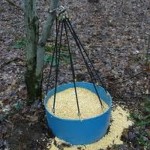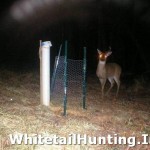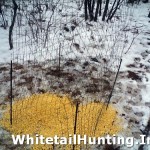Question: I have several whitetail bucks that I have not been able to see during daylight hours this whitetail hunting season. I know they are out there because I have them on camera, but I have been thinking about building an antler trap so that at least I will have their sheds. Has anyone tried this before, and what type of antler trap worked best? I know I can get these bucks to come to corn because they have been here all season, at night. Also, when do bucks begin to shed their antlers?
Answer: Antler traps are a great way to get your hands on some easy deer sheds. A lot of deer hunters will refer to these devices as antler traps or shed antler traps, but they are talking about the same thing. The most common type of rack trap consists of bait, usually corn, and either netwire or some type of elastic cord that a buck gets his antlers caught in while feeding.
A simple antler trap can be fashioned from a little hog wire or chicken wire and post or rebar to help entangle the sheds. Stake the hog wire in the shape of 3 or 4 tight “V” shapes. Pour corn or other bait in the very back of the “V” so that bucks have to push their horns into the wire to reach the bait. If the antlers are ready to drop, they’ll come right off when they hang up in the wire. Also, make sure to secure the wire loosely so that in the event that the antlers are not ready to drop the buck will not become completely trapped.
With the end of the whitetail deer breeding season coming to an end, it’s a good time to learn how to make an antler trap. This is because a buck’s testosterone levels fall off after breeding, resulting in his antlers also falling off. This varies depending on location, but usually occurs within about 2 months after the peak rut activity for an area. Deer sheds become increasingly “abundant” as late winter approaches. By the time it’s very early spring whitetail deer hunting will have been long over, but shed hunting is still good!





Good reading…….
I’ve always wondered about antler traps. I spend a lot of time looking for shed antlers in the spring and even early summer, but this article has given me some ideas. Will try to get a couple antler traps up and running next year.